Summary
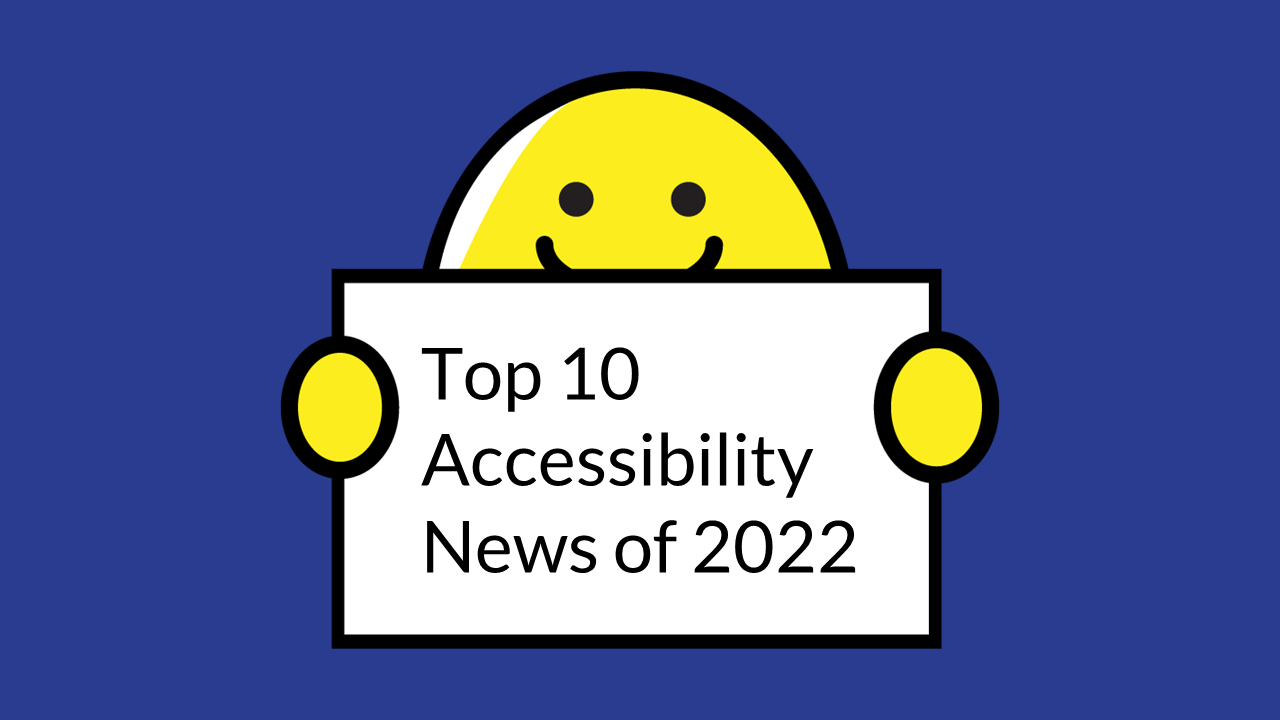
We scoured the many news announcements to find the most talked about accessibility news of 2022. We made a list. Checked it twice. Put it all into a form for you to decide. Here are the top 10 accessibility news of 2022 starting with No. 10.
10. Voting accessibility during the midterm elections
People with disabilities need to be able to fully participate in voting. This means voting must be accessible. All U.S. states are required to provide accessible voting machines for citizens with disabilities. The Help America Vote Act (HAVA) describes the requirement for ensuring the accessibility of voting machines.
HAVA requires at least one voting machine per polling place to be accessible. This includes offering audio output, Braille, large displays, and the ability to navigate using a keypad or other assistive technology. The Act also requires offering curbside voting for people who cannot enter the polling place, absentee voting for individuals unable to vote in person, and allowing election officials to provide assistance.
There were many reports of the elections not being accessible to people with disabilities. Here are examples.
Microsoft has partnered with the National Federal of the Blind to develop an accessible voting machine called the ElectionGuide. The U.S. Department of Justice has an Americans with Disabilities Act ADA Checklist for Polling Places. The White House issued a proclamation on International Day of People with Disabilities.
The proclamation stated there is more work to be done to ensure people with disabilities have equal rights. The proclamation that President Joe Biden signed mentioned the voting process: “Public spaces, including transit systems and voting locations, are still often inaccessible.”
9. Meetup adds an accessibility overlay
Equal Entry’s Meryl Evans caught Sumner Davenport’s LinkedIn post reporting that Meetup had added an overlay. Our team uses Meetup to manage A11yNYC, A11yVR, and A11yTokyo. It was unacceptable that Meetup added an overlay without a warning. Following Sumner’s recommendation, we immediately added the following disclaimer to our Meetup pages:
“As Web Accessibility professionals we do not approve or endorse the overlay that has been placed on this site without warning.”
Meryl shared Sumner’s post to help spread the word. She also emailed the Meetup accessibility team. They replied with the following:
“Thank you for sharing feedback regarding the newly-installed overlay. Our product and engineering teams are actively evaluating the situation and our widget use. Thanks again for taking the time to emphasize how important this is.”
Meryl shared the email and some questioned the genuineness of the reply. CEO of Equal Entry Thomas Logan tried the overlay. He turned on “low vision mode” and the results were unreadable.
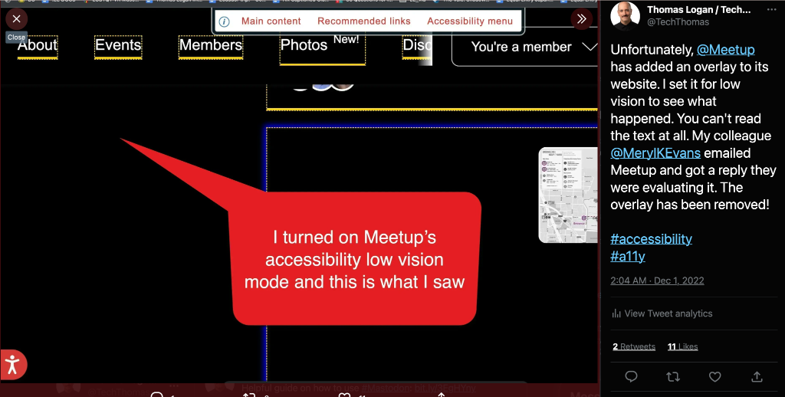
The team decided to wait and see what happens before acting. Within a couple of weeks, Meetup removed the overlay as revealed in a WPTavern post. This was a multi-community effort, not just WordPress.
8. Apple adds door detection and Live Captions to iOS
Apple’s newsroom announced various innovative accessibility additions. The two big ones were Door Detection and Live Captions.
Door Detection helps those who are blind or have low vision locate a door, know how far they are from it, and hear the door attributes. The user will know if the door is open or closed and whether they can open it by pulling, pushing, or turning a knob. If there are signs or numbers like an address on or around the door, Door Detection could announce them. The technology achieves this with a combination of a LiDAR camera and machine learning.

Apple also added Live Captions (beta) to help users follow any audio content. The captions could appear when users are on the phone, on FaceTime, on a video call, social media app, in an in-person conversation, or streaming media content. Meryl tried Live Captions and it needs work before it’s useable. (That’s why Apple released it as a beta.) As Meryl says, progress over perfection.
7. Microsoft introduces mix-and-match computer accessories
Microsoft Adaptive Accessories allows users to mix-and-match accessories including the Adaptive Mouse, Adaptive Hub, and Adaptive Buttons. The wireless accessories can replace or complement a traditional mouse and keyboard.
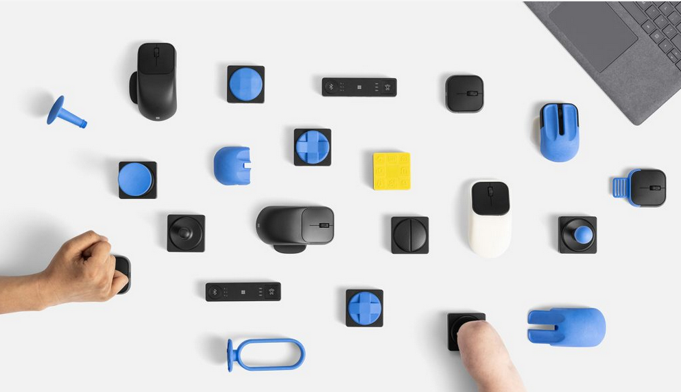
Users can customize the Adaptive Mouse with different attachments, including a mouse tail extension and thumb support configurable for the left or right hand. They can create custom inputs without a keyboard through the Adaptive Hub and Adaptive Button, which is available as a D-pad, joystick, and dual button. Users can further customize the mouse and button with 3D-printed attachments from Shapeways.
6. Proposed web and software accessibility legislation
U.S. Senator Tammy Duckworth (D-IL) and U.S. Representative John Sarbanes (D-MO) have introduced legislation to make websites and software applications more accessible for Americans with disabilities. It’s called the Websites and Software Applications Accessibility Act. Since they introduced legislation in both the U.S. Senate and House of Representatives, this is considered bicameral legislation.
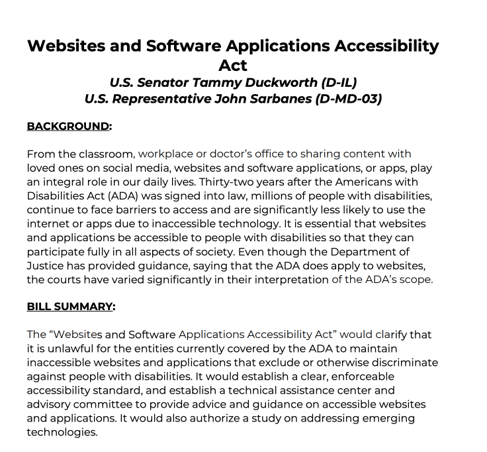
In the Senate, the legislation is identified as S. 4988 while in the House it is referenced as H.R. 9021. You can track these bills on the U.S. Congress website. The purpose of the proposed law is to codify accessibility requirements. Attorney Lainey Feingold’s blog is an excellent resource for information on this proposed legislation.
5. Airlines mishandle wheelchairs and passengers with disabilities
Where to begin with this one? Last year, disability rights advocate Engracia Figueroa lost her life as the result of “complications from injuries she sustained when United Airlines destroyed her custom wheelchair last July” per her attorneys’ words referenced in Wheelchair Travel.
The story explains the customized wheelchair supported her spinal cord injury and amputation of her left leg. The airport’s wheelchair did not have the pressure-relieving feature of her wheelchair. It caused her to get a pressure sore. United Airlines apparently fought against replacing the damaged wheelchair. Her death could have been avoided. Apparently, the airlines didn’t learn from this tragedy.
“Engracia Figueroa, a fierce advocate for people with disabilities, passed away on Sunday due to complications from injuries she sustained when United Airlines destroyed her custom wheelchair last July.” #FlyingWhileDisabled #Disability https://t.co/fUt8ruHqrV 1/3
— Maria Town (@maria_m_town) November 4, 2021
Maayan Ziv, founder and CEO of AccessNow and a disability activist, shared her experience of Air Canada breaking her wheelchair. Ziv’s Twitter thread explains she called the airline’s medical desk, submitted the dimensions of the wheelchair ahead of the trip, and arrive four hours early.
Here’s what happened with my wheelchair:
1. In advance of my flight I called the @AirCanada medical desk to confirm that the aircraft is large enough to carry my wheelchair. I also submitted the dimensions, weight, and other relevant information about my wheelchair in advance.
— Maayan Ziv (@maayanziv) September 8, 2022
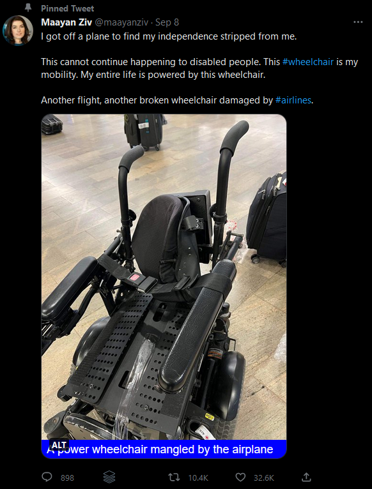
Despite her efforts, her wheelchair arrived at the destination damaged. The airline said it would pay for the full costs of the damage. Initially, they offered a $300 voucher. Hers wasn’t even the worse story.
Jennie Berry shared her story on LinkedIn with a video. Albastar Airlines told Berry she could not sit near the front of the plane. During the flight, she asked to go to the toilet. They responded they didn’t have an aisle chair onboard. Well, Berry needed to go and ended up dragging herself down the aisle while the staff went about their business. Upon arriving at the bathroom, the staff said “disabled people should wear nappies on board.”
The U.S. Department of Transportation says it’s working on adopting policies to ensure greater access during travel.
4. Apple, Google, Microsoft, Amazon, and Meta team up for speech recognition accessibility
Many people use speech recognition technologies in their everyday lives. They may instruct their phones what to do using their voice alone and dictate messages. However, this is not possible for people with different speech patterns and disabilities.
The goal of the Speech Accessibility Project is to improve speech technology for people with a range of diverse speech patterns and disabilities. The University of Illinois Urbana-Champaign will lead the project with support from Amazon, Apple, Google, Meta, and Microsoft.
The team of technologists, academic researchers, and community organizations will develop diverse speech data to make speech recognition interfaces more accessible for the diversity of speech patterns and disabilities. These companies are partnering with UIUC to eliminate duplication and ensure the collection of high-quality, representative speech samples.
3. Hearing aids sold over the counter without a prescription
Before October 2022, a patient would need to see a licensed audiologist to receive a prescription to obtain hearing aids. The U.S. Food and Drug Administration approved the sale of hearing aids over the counter without a prescription for people with mild-to-moderate hearing loss. This policy creates a new class of hearing aids that don’t require an evaluation or prescription.
Prescription hearing aids are like getting prescription glasses. A patient goes to an eye doctor who does an examination. The doctor creates a prescription for bifocals specific to the patient’s needs. But if someone needs basic reading glasses, then they can go to almost any drugstore to buy a pair without a prescription.
The hope is that this move will make hearing aids more affordable and accessible to the point that people with mild-to-moderate to get the hearing aids they need. Be aware that only certain types of OTC hearing aids can be sold without a prescription. It’s still strongly recommended to see a licensed health professional before investing in OTC hearing aids.
2. DOJ announces plan to adopt web accessibility guidelines for state and local governments
Lainey Feingold explains this in plain language in Deja Vu All Over Again? DOJ Announces Intent to Adopt Web Accessibility Regulations for State and Local Governments. There’s something else worth noting, which is the DOJ’s telehealth guidance as Lainey explains.
1. Twitter takeover that led to the accessibility team getting fired
The news of Elon Musk buying out Twitter and then firing the accessibility team is the overwhelming favorite for the top accessibility news in 2022. Gerard K. Cohen, engineering manager for the accessibility experience team at Twitter, tweeted a thread about the team’s firing.
I am officially no longer the Engineering Manager for the Accessibility Experience Team at Twitter. I have words. 🧵
— Gerard K. Cohen (@gerardkcohen) November 4, 2022
Our team is especially grateful to Gerard and his team. Occasionally, we’d embed tweets into blog posts. One day, we discovered an issue with the color contrast in the links. We also found that embedded tweets failed the link-name WCAG 2.4.4 and 4.1.2 tests.
You can see our tweets about it to the Twitter team here.
Howdy @TwitterA11y @TwitterAble some embedded tweets are failing the link-name link-name
WCAG 2.4.4, WCAG 4.1.2 test. Here’s one that fails: https://t.co/Wp55zog3ckThe @Equal_Entry team reported this in September 2021. Thanks.
— Meryl Evans, CPACC (@merylkevans) February 15, 2022
Gerard proactively let us know the team resolved the problem. We did our tests and they did! We wish all development teams were this responsive to accessibility issues.
We appreciated it when the team added automatic captions to Twitter Spaces. At the time, Clubhouse was enjoying the limelight despite not having captions. The team also rolled out the ALT badge on images. Users could select the ALT badge to view the alt text for the image. It did not require a screen reader. We’d like to see this on all platforms.
Here’s hoping 2023 is filled with great accessibility news. Accessibility is definitely getting more attention. As the following image shows, accessibility has gotten more attention in 2022.
Here’s hoping the trend continues skyrocketing into 2023.
Does Your Website or Technology Need to Be Audited for Accessibility or Get a VPAT?
Equal Entry has a rigorous process for identifying the most important issues your company needs to address. The process will help you address those quickly. We also help companies create their VPAT so they can sell to the government or provide it to potential clients who require it. If you’d like to learn more about our services for auditing and creating VPAT conformance reports, please contact us.